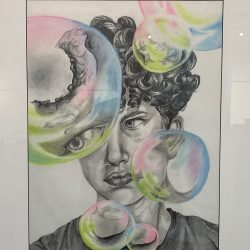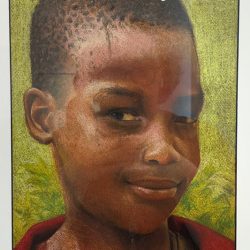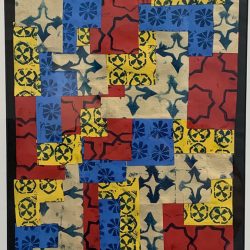About the Visual Arts Department
The Visual Arts department at TSA offers a rich, hands-on experience in multiple forms of visual media. The introductory, Arts Explorations, and Foundations of Art courses let beginning students create expressive work in drawing, painting, sculpture, ceramics, and other traditional mediums, and experimentation with unconventional materials, like glass, is also encouraged. Along with technical skill, personal style, and creativity, the visual art classes also address topics of cultural significance and art history. As students advance through the Visual Arts program, they may choose to continue their training in traditional fine art mediums and/or pursue interests in photography or graphic design.
Visual Arts Showcase



Course Descriptions
Art/Studio
This class is designed to help students become better artists and better at observational drawing skills! Students are taken through the process of learning how to look at objects in a way that helps you understand how to draw more realistically. They will learn all about the right side of your brain, and discover what it means to draw with that side. On the first day student draw a self portrait without any guidance. For the final exam, they will also do a self portrait using the tools, ideas and skills learned during the semester. The difference is amazing! Contour lines, negative space, value, and shading are just a few terms students become very familiar with!
7th grade art will emphasize exploration, analysis, and investigation of the creative process. Students develop technical skills that empower them to communicate ideas visually, with the focus on realistic and abstract representations of their environment. Students will be introduced to elements and principles of art and create artworks using a variety of 2 and 3 dimensional media. Art students develop technical, perceptual, expressive, critical and problem-solving skills.
Art Explorations is an art elective for junior high visual art students. This class is attended by students in grades 6th-8th. In this version of Art Explorations, students will learn about the traditional art of non-Western cultures from around the world while improving their art skills with a wide variety of mediums.
Part of a three year rotation. This course will only be available once for students during grades 6-8.
Art Explorations is an art elective for junior high visual art students. This class is attended by students in grades 6th-8th. This course covers a variety of both 2- and 3-dimensional methods and materials, while introducing students to American artists of the 20th Century.
Art Explorations is an art elective for junior high visual art students. This class is attended by students in grades 6th-8th. This course focuses on the history of European art from Ancient Rome to Impressionism.
Part of a three year rotation. This course will only be available once for students during grades 6-8.
In this class students will explore the basic fundamental elements of visual images through various art media including drawing, painting, sculpture, and mixed media. There is a strong emphasis on the history and architecture of the Western Art World. Time periods and styles covered include: Jewish, Early Christian and Byzantine Art, Middle Ages, Renaissance, Baroque and Rococo, Neoclassicism, Romanticism and Realism, Art of Late 1800. Observational drawing is taught, utilized and reinforced daily. Students are expected to keep an artist journal and complete specific requirements every quarter.
Studio 1 covers early 20th century European art movements through a combination of lectures and art projects incorporating a variety of mediums. Drawing skills and compositional techniques are emphasized and enhanced throughout the year-long course.
Prerequisite: Art Foundations, or 3 years visual art electives in grades 6-8, or by instructor permission.
Studio 2 develops students’ two-dimensional skills and portfolios. The class focuses on advanced techniques in drawing, printmaking, and painting mediums. Emphasis is on high-level observational drawing technique as well as development of a personal style.
Prerequisite: Studio 1. Studio 1 and Studio 2D may NOT be taken simultaneously.
Studio Art 3 provides students the opportunity to work in 3-dimensional mediums to create various types of artwork. During even-numbered school years (2014-2015, 2016-2017, etc.), content is based in clay, creating both functional (pottery) and sculptural artwork. Handbuilding, potter’s wheel, molding, and additive/subtractive sculpting, as well as various surface decoration techniques including glaze, underglaze, paint, carbon deposit, etc.
During odd-numbered school years (2015-2016, 2017-2018, etc.), content is based in metal and other complementary materials used to create jewelry, sculpture and other small works of art.
Fabrication, casting, and carving will be forming techniques used, as well as various surface decoration techniques including enameling and surface patinas. Examination of contemporary work in the mediums by various artists is a regular part of instruction.
NOTE: students may take the course twice (consecutive years) so as to explore the use of all 3-D materials and processes presented in the course.
Prerequisite: Studio Art 1 (C- or higher), or equivalent, or by instructor permission.
Students explore the medium of glass, and elements of design and production. Using a variety of techniques including slumping, screen-printing, and a wide variety of glass elements, they create kiln-formed work both for their personal achievement and for sale within the school’s gallery/store. The basics of graphic design are included.
Studio Art 4 provides students with the opportunity to create a strong portfolio for submission to colleges for admission to their art program, scholarship opportunities, and non-school art education facilities that require a portfolio for participation. The class also provides assistance to the student in selecting an area of artistic focus for study in college, college selection research, and applications for scholarship funds. Students in the course are typically asked to work on TSA and community visual art projects. Photo and graphic design focus students are encouraged to enroll in Studio Art 1 and Studio Art 2 prior to participating in Studio Art 4, as the majority of work created will be in traditional 2-D media (drawing, painting). A medium not included in other studio art track courses is also studied during the year. Past mediums have included architecture, functional product design and construction, and alternative materials sculpture. Examination of contemporary work by various artists will also be undertaken throughout the course of the year.
Graphic Design
During the first semester, students will be studying the Microsoft Office Suite – Microsoft Word, Microsoft Excel and Microsoft PowerPoint as well as hardware and Internet usage. During the second semester, students will explore the following software, Adobe Ideas, Illustrator, Photoshop Touch, Photoshop, and iMovie. Instruction is geared toward educating and assisting the student in computer terminology and proper use, internet safety, keyboarding, formatting of documents, spreadsheet development, computer based presentations and other basic word processing and page layout applications. Exploration of the Adobe Creative Suite software will develop software knowledge. Design terminology and process will also be explored.
This broad spectrum course will teach software and hardware use through a variety of projects. Students will gain exposure to Adobe Design software, print and scanning hardware, and technical processes used in the design industry. Beginning students spend the first year learning Illustrator, Photoshop, and InDesign, applying their creativity to build conceptual development skills. General topics explored include graphic print design, typography, and the use of digital photography, scanners and printers. Students work on projects that enhance their knowledge of typography, composition, components and conceptual processes which will include logo design, packaging design, poster design and a variety of projects that will enhance the creation of these products.
Prerequisite: Art Foundations, or 3 years visual art electives in grades 6-8, or by instructor permission.
Building on their Design 1 experience, students will gain greater exposure to the use of software, hardware, and technical processes used in the design industry as well as working with clients while applying their creativity and building conceptual development skills. General topics explored will include graphic print design and typography along with the use of digital photography, scanners and printers. Students will be working on projects that enhance their knowledge of typography, composition, components and conceptual processes. Intermediate students will be working with clients from the school and perhaps from outside the school. This process will be invaluable as they get to interact with clients in a Design Studio Experience.
Prerequisite: Successful Completion of Graphic Design 1.
Building on their Design 2 experience, students will gain exposure to a variety of design problems and experience more client interaction while applying their creativity and building conceptual development skills. General topics explored will include graphic print design and typography. They will also be working on designing for different printing processes like silkscreen as well as some printing. Advanced students will be working with clients from the Toledo area and the school. This process will be invaluable as they get to interact with clients in a Design Studio Experience.
Prerequisite: Successful completion of Graphic Design 2
Photography
Photography 1 presents a curriculum that covers the fundamentals of the photographic medium. Students will explore photographic art through the almost magical use of black and white film and darkroom based printing processes. Camera operation, composition construction, and controlled lighting techniques are covered, and applicable to digital camera photography as well. Development of the student’s ability to express their ideas through the art form is an objective that is also focused upon in the course. Additionally, the course explores photographic processes from earlier times, the photos and lives of notable photographers, and the effect of photography on our culture. Cameras and consumable photographic materials (film, photo paper) are provided by TSA.
Photography 2 presents a curriculum that is aimed at increasing the student’s skills in the use of the photographic medium, as well as furthering their skill development in artistic expression. Students will enhance their photographic imaging skills through the use of film and darkroom based printing processes, and the use of digital cameras and imaging software. Shooting assignments are undertaken in the studio and at existing locations. The course focuses on image making for fine art and commercial purposes. The course also explores photographic processes from earlier times, the photos and lives of notable photographers, and the effect of photography on our culture. Film cameras and consumable photographic materials (film, photo paper) are provided by TSA. Students must have a digital camera for use in the course. Acceptable digital cameras include small amateur cameras, DSLR, iPad, and cell phones with a camera feature.
Prerequisite: Successful completion of Photography 1 (C- or higher), or by instructor permission.
Photography 3 presents a curriculum that is aimed at increasing the student’s skills in the use of the photographic medium, as well as furthering their skill development in artistic expression. Students will enhance their photographic imaging skills through the use of film and darkroom based printing processes, and the use of digital cameras and imaging software. Shooting assignments are undertaken in the studio and at existing locations. The course focuses on image making for fine art and commercial purposes. The course also explores photographic processes from earlier times, the photos and lives of notable photographers, and the effect of photography on our culture. Film cameras and consumable photographic materials (film, photo paper) are provided by TSA. Students must have a digital camera for use in the course. Acceptable digital cameras include small amateur cameras, DSLR, iPad, and cell phones with a camera feature.
Prerequisite: Successful completion of Photography 2 (C- or higher), or by instructor permission.
Photography 4 presents a curriculum that is aimed at increasing the student’s skills in the use of the digital photographic medium, as well as furthering their skill in communicating through the medium. Students will enhance their photographic imaging skills through the use of digital cameras and imaging software. Limited film and darkroom work will also be included. Shooting assignments are undertaken in the studio and on location. The course focuses on image making for commercial and fine art purposes including high-end personal and corporate portraiture, and alternative fine art imaging. Film cameras and consumable photographic materials are provided by TSA. Students must have a digital camera for use in the course. Acceptable digital cameras include small amateur cameras, DSLR, iPad, and cell phones with a camera feature. Examination of photographs created by contemporary artists will also be undertaken throughout the course of the year.
Prerequisite: Successful completion of Photography 3 (C- or higher), or by instructor permission.
